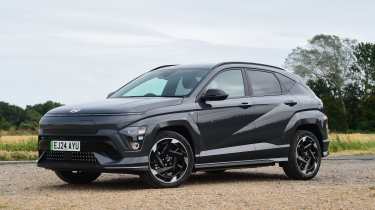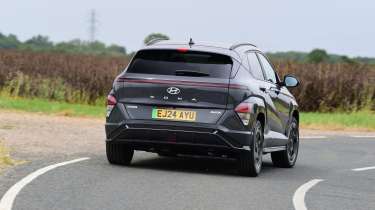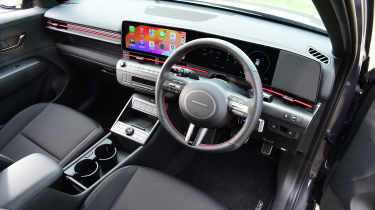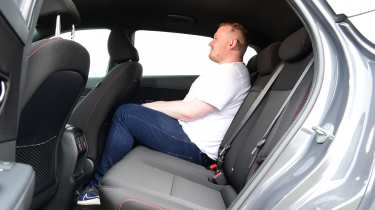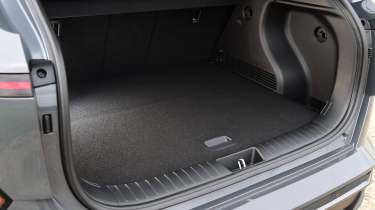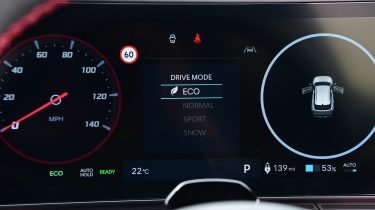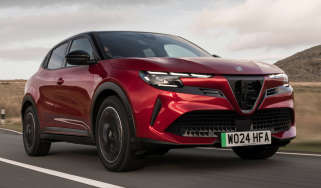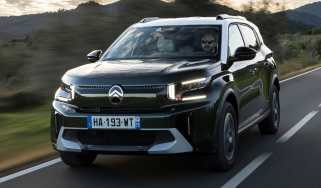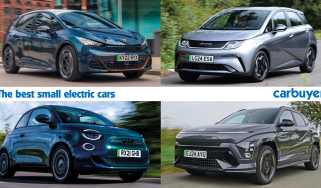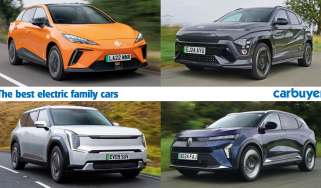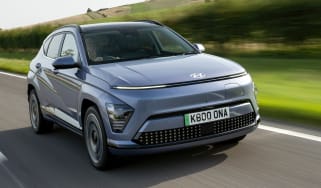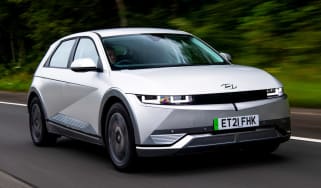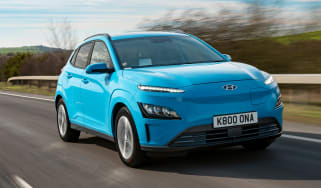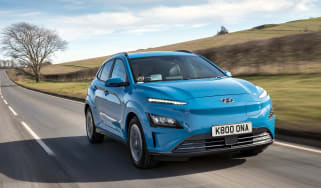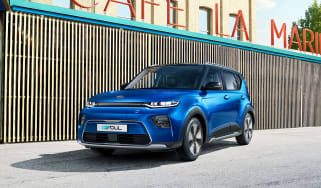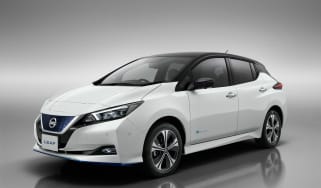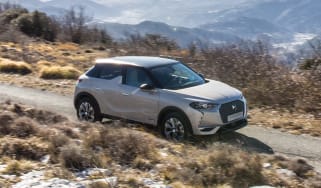Hyundai Kona Electric review – more refined, spacious and upmarket than before
“The latest Hyundai Kona Electric is more spacious, refined and upmarket than its predecessor, making it a serious contender for the small SUV throne”
Pros
- Improved practicality
- Upmarket interior
- Solid EV powertrains
Cons
- Mediocre charging speeds
- Conservative interior styling
- Unexciting to drive
Verdict – is the Hyundai Kona Electric a good car?
The original Hyundai Kona was an incredibly well-received car, but the brand has clearly listened to the feedback of its passionate owners. Criticisms over its interior space have been roundly addressed, and the Kona Electric feels even more grown-up inside, thanks to plush materials and a pleasing blend of technology and intuitive controls. Its EV powertrain still impresses, and unlike its Kia Niro EV sister car, there’s a choice of a smaller – and more affordable – battery and motor. It all adds up to make the Kona Electric one of the best electric cars on sale.
Hyundai Kona Electric models, specs and alternatives
The Hyundai Kona Electric is a small SUV that isn’t lacking in rivals as this part of the new car market heats up. Several, like the Peugeot E-2008, Vauxhall Mokka Electric and DS 3 hail from under the Stellantis umbrella, so share similar vital statistics. Then there are other contenders like the Renault Megane E-Tech, MG4, Smart #1 and Volkswagen ID.3 and ID.4.
 The 10 best electric cars in 2025
The 10 best electric cars in 2025
While the original Kona was a hit, it didn’t score well for practicality and suffered by having a smaller boot than most rivals, along with somewhat claustrophobic rear seats. Hyundai has addressed this by increasing the second-generation Kona’s size – it shares its new underpinnings with the Kia Niro EV – and the result is a much roomier cabin, while it still slots in neatly beneath the larger Hyundai Tucson.
More reviews
Kona trim levels kick off with Advance, followed by N Line, N Line S and Ultimate. All cars get 17-inch wheels, along with a reversing camera and even dual 12.3-inch displays. N Line adds a sportier look inside and out, as well as tech like a powered tailgate and a wireless smartphone charger, but it isn’t actually any faster or sharper to drive. Ultimate changes its looks again with a full-width LED strip adorning its nose, as well as items like an enhanced sound system and sunroof.
At launch there are two powertrains, including a more affordable option with slimmed-down specs for those who don’t travel long distances frequently. This gets a 48kWh battery and 154bhp motor, while Kona Electric buyers after more power and range can order the 65kWh battery and 215bhp front motor, providing a range of up to 319 miles. Its charging system isn’t quite as rapid as we’ve seen with models like the Hyundai Ioniq 5, with a 10 to 80% top-up taking 43 minutes.
|
Trim levels |
Power options |
|
|
Hyundai Kona Electric alternatives
Manufacturers are racing to switch to electric, and the popular small SUV class is being transformed more quickly than most. There are already lots of contenders here, and even the top-selling Ford Puma will soon be offered with an electric motor.
Range, charging & running costs
Unlike its Kia Niro EV sister car, the Kona Electric comes with the option of a cost-cutting 48kWh battery, and we’ve now tested both versions. The smaller battery gives the Kona a provisional electric range figure of up to 234 miles, while the larger capacity extends this to a maximum of 319 miles in Advance trim.
Both figures are competitive for their respective price brackets, with the 48kWh pack managing a few more miles than the entry-level Citroen e-C4. The Kona’s headline 319-mile figure is substantially ahead of the 251 miles of the facelifted Peugeot E-2008, too, and even beats the Renault Megane E-Tech’s 280-mile maximum.
During our time with the Kona Electric fitted with both battery sizes, we also found they could get close to their claimed figures over a mixture of routes in mild conditions. An efficiency-improving heat pump should also make them better able to repeat this performance in colder weather. Even the Kona Electric N Line with its larger alloy wheels managed an average of 3.8 miles/kWh in our hands, equating to a real-world range figure of around 245 miles.
With a 400-volt electrical system instead of the pricier 800-volt architecture of the Hyundai Ioniq 5 and Ioniq 6, the Kona’s charging speeds won’t be quite as blazing fast. With speeds limited to 101kW in the 65kWh battery version (74kW for the 48kWh model), a burst from 10 to 80% in just under 43 minutes should be fine for most owners, but this isn’t a class leader. A 7.4kW home wallbox can fully charge the 48kWh battery in six hours, while the 65kWh takes eight hours.
Like all relatively affordable EVs, the Kona Electric will help motorists switching from petrol and diesel models save some money on their bills. VED (road tax) is free until the 2025 rule changes, and drivers can enter low emissions zones like the London Congestion Charge for free. Company car drivers get the biggest benefits, thanks to the low Benefit-in-Kind (BiK) band for EVs, mounting up to big monthly savings.
|
Model |
Battery size |
Range |
|
Kona Electric 48kWh |
48kWh |
234 miles |
|
Kona Electric 65kWh |
65kWh |
319 miles |
Insurance
The Hyundai Kona Electric with the 48kWh battery sits in group 25, while the more powerful versions with the larger 65kWh battery sit in groups 31 or 32 (N Line S) out of 50 for insurance. That’s a little more expensive than the Citroen e-C4, which sits in groups 22 and 23, but much less expensive than the Honda e:Ny1 in group 43.
Electric motor, drive & performance
Our time with the latest Kona Electric left us with a sense that it’s a more mature machine than the previous model all around. Even over undulating tarmac, the Kona Electric is now more comfortable without its wheels and body getting out of sync, and it’s especially comfortable on the 17-inch wheels of the Advance trim.
From behind the wheel, the Kona Electric feels unflustered more of the time, making it reassuring to drive and relaxing for passengers. The suspension does a decent job of isolating potholes and speed bumps from the cabin, and you’ll barely notice them through the steering wheel. Speaking of which, the steering is smooth and consistent, but like most cars in this class, there isn’t too much feedback. But that’s even the case with more overtly sporty electric SUVs like the BMW iX1.
Unlike the blistering Hyundai Ioniq 5 N, the Kona Electric N Line just gets visual upgrades, so while its 215bhp motor certainly feels peppy, it’s no faster or more agile than the standard car. It’s very accomplished, but not overly exciting as a result.
0-62mph and top speed
Kicking off the range is the entry-level 154bhp version, with a single motor sending its power straight to the front wheels via a single-speed transmission. Acceleration from 0-62mph in 8.8 seconds isn’t to be sniffed at, and drivers making the switch from fossil-fueled small SUVs will find it punchy without being otherworldly.
Key to this is the fact its torque output is the same as the more powerful version. There’s instant grunt available at urban speeds, and while it doesn’t feel quite as quick at motorway speeds, enough power remains to pass slower traffic.
During our testing of the 215bhp version – which is also front-wheel drive – its power felt like more than you’d ever need in this sort of small family SUV. Its refinement also impressed, with almost no whine or hum from the electric motor meaning that wind rush and tyre noise are the only noticeable sounds as you pick up speed – both of which are also well contained.
There are four levels of regenerative braking toggled by the paddles behind the steering wheel, and on its strongest setting, the Kona Electric is capable of ‘one-pedal driving’. We also found this mode offered enough braking when tackling a twisty B-road, and actually preferable to having it fully off and relying on the brake pedal, which requires quite a firm prod to slow the car down.
|
Model |
Power |
0-62mph |
Top speed |
|
Kona Electric 48kWh |
154bhp |
8.8s |
104mph |
|
Kona Electric 65kWh |
215bhp |
7.8s |
104mph |
Interior & comfort
Hyundai designed the latest Kona to be electric first and foremost, instead of adapting a combustion-engined car, like it did with the first-generation Kona. This is most evident inside, where the Kona Electric feels more spacious, airier and far better at storing odds and ends – all without feeling too cluttered.
It’s noticeably more premium too, with less of the shiny, scratchy hard plastics you’d find in Hyundais from just a few years ago. Everything you look at or touch frequently is now soft and although there are a few harder plastics, these feel like they will stand up to years of abuse. While it certainly errs on the side of being conservative, there are also some splashes of metallic trim to lift the ambience.
Infotainment and navigation
Much of the Kona Electric’s interior styling hangs off the twin 12.3-inch screens that stretch out from behind the steering wheel and perch above the centre console. When combined with the interior’s soft but bright colours, they give the Kona a light and contemporary look. Unlike many rivals, though, fans of physical buttons and switches will feel encouraged that Hyundai has kept knobs for key functions like climate control.
While dual screens will be familiar to plenty of Hyundai owners, the Kona Electric also gets a new interface with configurable widgets that are easier to navigate. Its graphics are sharp and look neat without being too fussy – there’s no animated fox, as found in the Smart #1 – while it feels intuitive and responsive to touches and swipes. It’s admittedly not as quick as the system offered in the Honda e:Ny1, but it’s easier to navigate and on-screen graphics are larger and easier to read.
While the Bose sound system is very good, we actually preferred the standard sound system fitted in the Honda e:Ny1 when we tested them side by side.
Buyers can also opt for a £600 Comfort pack, adding heated front and rear seats, a heated steering wheel, a wireless smartphone charging pad and tinted rear windows. There’s even the neat option of a heated charging door, so even in winter, there shouldn’t be any issues with the door getting jammed or frozen shut. We’d pick the Lux Pack which costs £1,600 and adds lots of extras including Highway Drive assist, a remote parking feature activated via the key fob, and the ability to open your Kona Electric via your smartphone.
The N Line trim brings sports seats with corresponding motifs, red contrasting stitching around the cabin, and even red accents for the dashboard and air vents, along with aluminium pedals. It feels nicely premium, even if the black theme can make the cabin feel a bit dark on a cloudy day in Britain.
Key features | |
|
Advance
|
N Line (Advance plus…)
|
|
N Line S (N Line plus…)
|
Ultimate (N Line S plus…)
|
Practicality & boot space
As we’ve alluded to already, the Kona Electric has grown quite a bit for its second outing, and it’s now 175mm longer, with 60mm extra between the front and rear wheels. This, along with improvements to its interior design and packaging, makes it feel far bigger inside than the old Kona.
It also means the Kona Electric now feels quite a bit larger inside than rivals like the Vauxhall Mokka Electric, and the smaller DS 3. Despite a swept-back look thanks to angular C-pillars, the Kona still offers plenty of headroom. Four reasonably tall adults will be able to stretch out quite a bit in the Hyundai, and while three people in the back would need to be pretty friendly with one another, the flat floor at least means there will be no fighting for foot space.
There are plenty of storage cubbies, bins and cupholders to put your odds and ends, along with a large central storage compartment between the front seats. Thanks to Vehicle-to-Load (V2L) charging with an included three-point-pin adaptor, you can even use the Kona Electric’s large battery to power external devices like a computer, fridge or movie projector, and potentially even give another EV a boost if its battery is running low.
|
Size comparison | |||
|
Model |
Length |
Width |
Height |
|
Hyundai Kona Electric |
4,355mm |
1,825mm |
1,575mm |
|
Peugeot E-2008 |
4,300mm |
1,770mm |
1,550mm |
|
MG4 |
4,287mm |
1,836mm |
1,504mm |
|
Vauxhall Mokka Electric |
4,151mm |
1,791mm |
1,531mm |
Boot space
One of the best examples of the increase in the Kona’s size is its boot volume, which has shot up from 332 litres to 466 litres – addressing one of the most common owner complaints about the old Kona. While it’s a few litres down on the squarer Kia Niro EV, it’s more space than most of its rivals offer. Fold the Kona’s seats down and that number increases to 1,300 litres – helpful for trips to the furniture store. There’s even more space under the boot floor which is handy for storing the charging cables or a first aid kit.
While some EV models also have a ‘frunk’ storage area under the bonnet, lift the Kona Electric’s and you’ll be greeted with what looks like a plastic engine cover. This does have a hatch that opens to reveal a small compartment, but it’s only really big enough as an alternative space for a charging cable or tool kit.
|
Boot space comparison | |
|
Model |
Boot space |
|
Hyundai Kona Electric |
466/1,300 litres |
|
Peugeot E-2008 |
434/1,476 litres |
|
MG4 |
363/1,177 litres |
|
Vauxhall Mokka Electric |
310/1,060 litres |
Reliability & safety
The new Hyundai Kona has big shoes to fill, because the outgoing model came fourth in our 2022 Driver Power results and only slipped to 16th in 2023, despite nearing the end of its life. The most recent Kona Electric hasn’t yet appeared in our results. Owners loved the Mk1 Kona’s infotainment setup and reliability, but it could only manage a 54th place (out of 75 models) for practicality – an area where the new Kona should score more highly.
We do have Driver Power figures for the Hyundai brand as a whole, and it came a middling 17th out of 32 manufacturers, with a reasonable 22.8% of owners reporting a first year fault. It was in the lower half of the table in most categories, but posted an 11th spot for running costs, 12th for value for money and 16th for its safety features.
Safety
The Kona Electric hasn’t been independently crash-tested by Euro NCAP yet, but we wouldn’t be at all surprised if it matches the five-star score of the Kia Niro EV. Every Kona will be fitted with a host of safety features, including tech to help avoid collisions and keep the car from wandering out of its lane on the motorway.
Higher trims will add the roster with features that can help park the car for you, and warn occupants if they go to open a door into the path of traffic or other road users.
Which Is Best?
Cheapest
- Name160kW Advance 65kWh 5dr Auto
- Gearbox typeAuto
- RRP£34,265
Most Economical
- Name160kW Advance 65kWh 5dr Auto [Comfort Pack]
- Gearbox typeAuto
- RRP£34,865
Fastest
- Name160kW Advance 65kWh 5dr Auto
- Gearbox typeAuto
- RRP£34,265


